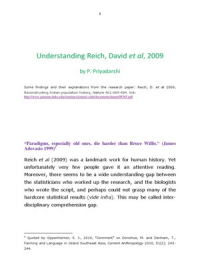shiv wrote:Dubeyji, on the topic of language corruption...
Sir, it greatly pains me to end my otherwise good day by spending time refuting these half-wits. But I must, as I have been asked to do so by many on this thread.
ManishH wrote:Sanskrit does have some very old phonemes. But a lot are missing which he neglects to mention.
1) We all know that Vedic is "very old". We do not need ManishH to tell us that. The real question is:
what is "older" than Vedic ? Nothing but a hypothetical PIE which does not exist, nobody has a single recorded word of it. "A lot of phonemes are missing". Missing from what ? What is the older language in relation to which they are "missing" ? What proof exists of this older language ?
2) The so-called "missing phonemes" are some harsh sounds which are produced in the throat. These are associated more with apes and monkeys:
http://www.haskins.yale.edu/SR/SR013/SR013_05.pdf
It is possible some primitive humans (such as Hittites, Anatolians) may have still been practising such sounds at the time of Vedic language being developed from the RV sounds in India. So what ? How does this prove that such languages are "older" than Vedic ?
These linguistics guys presume that all humans have to dumbly and passively follow the same "sound change laws" at the same speed (as a scientist, I find the idea that these nonsensical speculations are called "laws", to be
abominable). Even if it is assumed that Vedic is an "evolved" language, what prevented humans in India from being smarter than Hittites and Anatolians? Couldn't they have not only started speaking much earlier, but also refined their speech much earlier?
The linguist argument is like saying: "Today I visited the Jhumritalaiya College which has very primitive facilities, hence it must be older than Cambridge and Harvard which have much more modern facilities".
Kazanas wrote: The Vedic language as seen in the RV alone, despite much obvious attrition and several innovations, has preserved many more features from the putative PIE language and wider culture. This was due to its well attested and incomparable system of oral tradition
More nonsense from Kazanas. Maybe the old Yavana is smoking something really strong that allows him to see "obvious attritions" and "innovations". Obvious attritions from fawking what ? Obvious innovations from fawking what ? In comparison to the "immaculate conception", all childbirths are going to appear sinful and corrupted to the nutjobs who believe in such nonsense. That is what these fellows are all going on about. PIE is some sort of "immaculate conception" which we are supposed to just believe even though there is absolutely not a shred of testimony that supports it.
ManishH wrote:He's not aware of metrical anomalies in Rg which point to several instances where original disyllabic sounds were lost and became unisyllabic. If he has bothered to actually listen to samhita pāṭha, he would have noticed the hiatus.
I thought I had addressed this bull$hit already in my previous exchange with ManishH. We are dealing with a very dishonest individual. On one hand, he wants us to believe that there was some unknown PIE language from which Vedic descended, and on the other hand he wants us to believe that *well known* and *well preserved* sounds in the Rgveda have actually been lost.
O prize idiot, just because there are some people who are currently practising the wrong pronunciation, does not mean that the Rgvedic sounds have "lost" their correct pronunciation. The correct pronunciation,
as clearly given in the Rgveda pratishakhya, describes how to get all the "disyllablic" features and they can easily be reproduced by somebody who is conversant with it. There is no question of it being "lost" because there is a permanant record of it and it can regained by anybody who wants to do so, with a minimal effort.
Instead of realizing this great heritage and the great efforts of the Vedic grammarians and phoneticians to preserve the primeval sounds of the Rgveda, these third-class fellows waste their time filling up entire books and websites with utter nonsense, conjuring up their own fantasies and fake theories, and at the same time trying to destroy the integrity of the Vedic heritage. It's a damned shame.
KL

